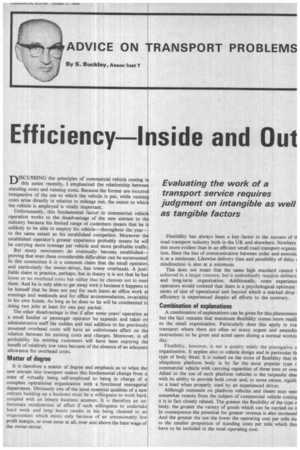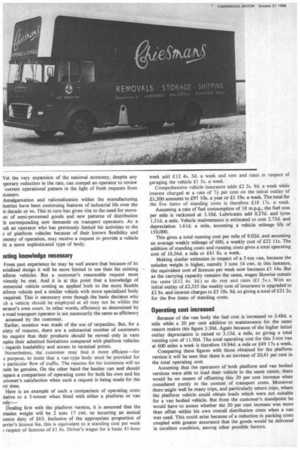Efficiency I side and Out
Page 79

Page 80

If you've noticed an error in this article please click here to report it so we can fix it.
Evaluating the work of a transport service requires judgment on intangible as well as tangible factors
DISCUSSING the principles of commercial vehicle costing this series recently, I emphasized the relationship betwee standing costs and running costs. Because the former are incurre irrespective of the use to which the vehicle is put, while runnin costs arise directly in relation to mileage run, the extent to whic the vehicle is employed is vitally important.
Unfortunately, this fundamental factor in commercial vehicl operation works to the disadvantage of the new entrant to th industry because his limited range of customers means that he i unlikely to be able to employ his vehicle—throughout the year to the same extent as his established competitor. Moreover th established operator's greater experience probably means he wil be carrying more tonnage per vehicle and more profitable traffic
But many newcomers do eventually become established proving that even these considerable difficulties can be surmounted In this connection it is a common claim that the small operator and particularly the owner-driver, has lower overheads. A justi fiable claim in practice, perhaps, but in theory it is not that he h lower or no overhead costs but rather that he chooses not to mee them. And he is only able to get away with it because it happens ts be himself that he does not pay for such items as office work a evenings and weekends and for office accommodation, invariabl in his own house. As long as he does so he will be condemned t doing two jobs at least for one pay packet.
The other disadvantage is that if after some years' operation a a small haulier or passenger operator he expands and takes o administrative staff the sudden and real addition to his previousl assumed overhead costs will have an unfortunate effect on th relation between his existing costs and charges. Moreover, in probability his existing customers will have been enjoying th benefit of relatively low rates because of the absence of an adequat allowance for overhead costs.
Matter of degree It is therefore a matter of degree and emphasis as to when the new entrant into transport makes this fundamental change from a state of virtually being self-employed to being in charge of a complete operational organization with a functional managerial department. Obviously one of the most essential qualities of a new entrant building up a business must be a willingness to work hard, coupled with an inborn business acumen. It is therefore an unfortunate misdirection of effort if such willingness to undertake hard work and long hours results in his being chained to an organization which exists only because of an unreasonably low profit margin, or even none at all, over and above the bare wage of the owner-driver.
Flexibility has always been a key factor in the success of ti road transport industry both in the UK and elsewhere. Nowhere this more evident than in an efficient small road transport organiz tion. Here the line of communication between order and executic is at a minimum. Likewise delivery time and possibility of delay t misdirection is also at a minimum.
This does not mean that the same high standard cannot I achieved in a larger concern, but it undoubtedly requires delibera and long-term organization. Additionally, some experience operators would contend that there is a psychological optimum terms of size of operational unit beyond which a marked drop i efficiency is experienced despite all efforts to the contrary.
Combination of explanations A combination of explanations can be given for this phenomeno but the fact remains that maximum flexibility comes more readil to the small organization. Particularly does this apply in roa transport where there are often so many urgent and amendin instructions to be given and acted upon during a normal workin day.
Flexibility, however, is not a quality solely the prerogative o organization. It applies also to vehicle design and in particular th type of body fitted. It is indeed on the score of flexibility that th ubiquitous platform body is by far the most popular type c commercial vehicle with carrying capacities of three tons or ovei Allied to the use of such platform vehicles is the tarpaulin shee with its ability to provide both cover and, to some extent, rigidit: to a load when properly used by an experienced driver.
Although comment on platform vehicles and sheets may seen somewhat remote from the subject of commercial vehicle costing it is in fact closely related. The greater the flexibility of the type o body, the greater the variety of goods which can be carried on it In consequence the potential for greater revenue is also increased And the greater the use the lower the operating cost per mile dui to the smaller proportion of standing costs per mile which thei have to be included in the total operating cost. Yet the very expansion of the national economy, despite any worary reduction in the rate, can compel an operator to review current operational pattern in the light of fresh requests from itomers.
Amalgamation and rationalization within the manufacturing lustries have been continuing features of industrial life over the st decade or so. This in turn has given rise to the need for movelit of semi-processed goods and new patterns of distribution :h corresponding new demands on transport operators. As a ;ult an operator who has previously limited his activities to the e of platform vehicles because of their known flexibility and Jnomy of operation, may receive a request to provide a vehicle th a more sophisticated type of body.
isting knowledge necessary From past experience he may be well aware that because of its ecialized design it will be more limited in use than his existing atform vehicles. But a customer's reasonable request must viously be met. And it is at this point that a knowledge of mmercial vehicle costing as applied both to the more flexible atform vehicle and a similar vehicle with more specialized body required. This is necessary even though the basic decision why ch a vehicle should be employed at all may not be within the ierator's own court. In other words,-efficiency as determined by e road transport operator is not necessarily the same as efficiency assessed by the customer.
Earlier, mention was made of the use of tarpaulins. But, for a iriety of reasons, there are a substantial number of customers ho require that their products should be moved only in vans :spite their admitted limitations compared with platform vehicles ; regards loadability and access to terminal points.
Nevertheless, the customer may find it more efficient—for s purpose, to insist that a van type body must be provided for s particular flow of traffic. The reasons for his insistence will no aubt be genuine. On the other hand the haulier can and should :.epare a comparison of operating costs for both his own and his zstomer's satisfaction when such a request is being made for the rst time.
Here is an example of such a comparison of operating costs :lative to a 5-tonner when fitted with either a platform or van ody:— Dealing first with the platform version, it is assumed that the nladen weight will be 2 tons 17 cwt. so incurring an annual cence duty of £63. Inclusive of the appropriate proportion of arrier's licence fee, this is equivalent to a standing cost per week respect of licences of £1 6s. Driver's wages for a basic 41-hour week add £12 4s. 3d. a week and rent and rates in respect of garaging the vehicle £1 5s. a week.
Comprehensive vehicle insurance adds £2 2s. 9d. a week while interest charged at a rate of 7; per cent on the initial outlay 'a £1,300 amounts to £97 10s. a year or £1 19s. a week. The total for the five items of standing costs is therefore £18 17s. a week.
Assuming a rate of fuel consumption of 18 m.p.g., the fuel cost per mile is reckoned at 3.10d. Lubricants add 0.27d. and tyres 1.31d. a mile. Vehicle maintenance is estimated to cost 2.73d. and depreciation 1.61d. a mile, assuming a vehicle mileage life of 150,000.
This gives a total running cost per mile of 9.02d. and assuming an average weekly mileage of 600, a weekly cost of £22 11s. The addition of standing costs and running costs gives a total operating cost of 16.56d. a mile or £41 8s. a week.
Making similar estimates in respect of a 5-ton van, because the unladen weight is higher, namely 3 tons 14 cwt. in this instance, the equivalent cost of licences per week now becomes £1 14s. But as the carrying capacity remains the same, wages likewise remain the same (£12 4s. 3d.) as do rent and rates (£1 5s.). With an initial outlay of £2,355 the weekly cost of insurance is upgraded to £2 8s. and interest charges to £3 10s. 9d. so giving a total of £21 2s. for the five items of standing costs.
Operating cost increased
Because of the van body the fuel cost is increased to 3.48d. a mile while a 20 per cent addition to maintenance for the same reason makes this figure 3.30d. Again because of the higher initial outlay depreciation is raised to 3.13d. a mile, so giving a total running cost of 11.50d. The total operating cost for this 5-ton van at 600 miles a week is therefore 19.94d. a mile or £49 17s a week.
Comparing these figures with those obtained for the platform version it will be seen that there is an increase of 2041 per cent in the total operating cost.
Assuming that the operators of both platform and van bodied versions were able to load their vehicle to the same extent, there would be no means of offsetting this 20 per cent increase when considered purely in the context of transport costs. Moreover there might well be many trips, and particularly return trips, where the platform vehicle could obtain loads which were not suitable for a van bodied vehicle. But from the customer's standpoint he would have to assess whether the 20 per cent increase was more than offset within his own overall distribution costs when a van was used. This could arise because of a reduction in packing costs coupled with greater assurance that the goods would be delivered in excellent condition, among other possible factors.












































































































































